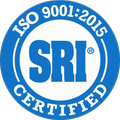Machining:
High speed steel and carbide tools may be used to machine vanadium. Speed as well as tool angles and lubrication should be monitored to avoid galling.
Turning:
See general instructions for turning vanadium given in table 1. These instructions are recommended
as a starting point for working with vanadium. Adjustments to these procedures should be made to accommodate the different compositions of each vanadium alloy.
Forming
Vanadium has excellent cold working properties and can be forged, rolled or swaged at room temperature. Annealing is necessary after 80 to 85% reduction of the cross sectional area. Vacuum annealing (<1 x 10-4 TORR) at 900° C for 1-1/2 hours will cause complete recrystallization of cold worked material. Vanadium is well suited to deep drawing and exhibits little springback.
Vanadium cannot be redily anodized like other reactive and refractory metals. Tantalum forms the best anodic films for capacitors but vanadium (although forming a protective oxide at low temperatures) will not sespond to normal anodizing techniques. The principle oxide of vanadium is V205 which melts at 675° C and is corrosive. Vanadium and it’s alloys must be fabricated below the melting point of the oxide or must be protected from an oxidizing atmosphere if higher temperatures are used.
Welding:
As Vanadium suppliers, we know that it is very reactive with gases nitrogen, oxygen and hydrogen, therefore, precautions must be taken to protect any weld from these gases. TIG and plasma welding work well when precautions are taken to flood all surfaces of the weld (front & back) with inert gas (argon, helium).
Vanadium can be welded to most of the transition metals and their alloys. Welding with titanium, zirconium, tantalum and chromium as well as austenitic and ferritic stainless has been successful. Welding to other steels is possible if chromium is introduced into the weld at the time of welding.






